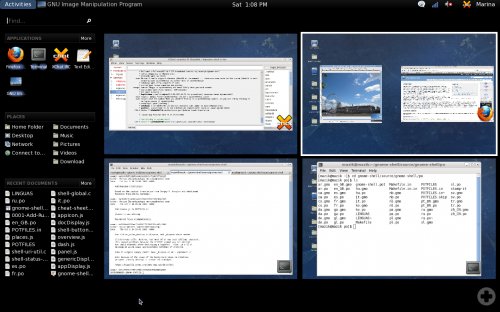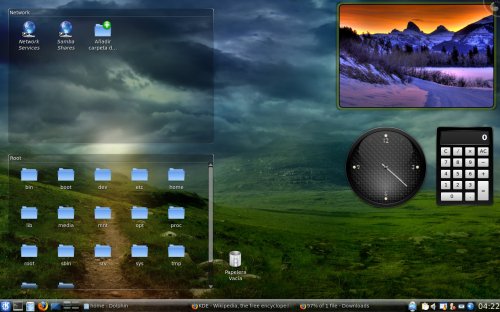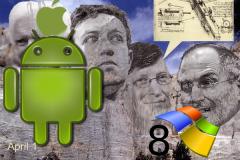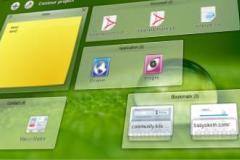Seven, the last real Windows?
The long-awaited release of Windows 7 continued in euphoria with the success of sales of the latest version of the operating system from Microsoft .
But this led to the remark that Microsoft is a company that is not capable of developing.
Despite the fact that users were pleased to find a more reactive OS, Seven is just a new version of Vista, improved by small borrowings from MacOs, which seeks to remove its flaws without really achieving this, and most importantly, bringing nothing really new to the interface.
And we see, given recent events, especially Balmer's crusade against Google, that Microsoft is afraid for its future, just as Apple is afraid of Android, which threatens its iPhone.
This prompts us to conduct a review of competing products, and we will see that in fact the user interface can actually change the working or leisure space on the computer.
Windows
The Seven is a draft of new, poorly thought-out ideas and never rethought old principles. A few obvious examples:
- Arrows on icons to indicate tags. What's the real benefit? Each icon in the office is covered with an arrow, it wants to highlight something ?
- Wallpaper screens that change at regular intervals: this is alarming, the transition effect would be desirable. We didn't think about it in Redmond .
- That the window goes full-screen as it's moved to the edge is the most disturbing behaviour imaginable. You never move the window on the side except to see other windows better !
Windows was designed according to two principles:
- A monolithic design that makes it difficult to replace the interface manager, as is done in Linux, where they choose between Gnome and KDE, or another system.
- Support for applications such as Office, Visual Studio. Once you have purchased one of these apps, you can no longer change the app system. It is necessary to switch to new versions of Windows, which, in turn, force us to buy applications for Windows.
This principle of reliance on OS and apps forces Microsoft into a spiral of success when you buy Windows for your apps and apps because they're made for Windows and because it's Microsoft software.
However, this model is under threat due to the development of web applications that provide the most common data processing methods in the office area. It no longer depends on the specific OS. And the user who has not installed anything on his computer no longer depends on the editor: he can change the application at any time.
Chrome OS
The operating system for web applications can, due to some features, replace the system for local applications.
These functions are mainly a proprietary client that allows you to run your own applications in the browser, and webGL, which provides 3D web application capabilities.
Designed for netbooks and mobile devices, it will eventually be able to evolve and switch to local mail.
Gnome
It is from the developing version 3 that Gnome will really update the user interface.
Gnome Shell is based on the concept of activity, a concept already present on Android. The action consolidates all related objects in the workspace on the application desktop. This frees up space from everything that is not related to current tasks.
Of course, it is easy to move from one space to another, and elements to move from one space to another.
On the Gnome desktop, you can find, in addition to the action areas, application icons, location icons or find files, as well as icons of the last used files, which can be resumed without re-searching. This system, a time called Zeitgeist, calls itself an "activity diary."
Quick access to documents is the main concern of the interface. Several videos explain his work.
The Win2-7 Pack theme also gives Gnome the look of Windows 7.
For those who prefer the Gnome 2 interface, the Mint distribution offers a fork named Mate that works with Gnome 3. She even offers an adaptation of Gnome 3 that makes it work like a classic desktop and eliminates its flaws.
Note that since Ubuntu adopted the Unity interface, Mint has 40% more users disappointed with this distribution.
- Dwarf Shell. Presentation.
- Dwarf 3. Especially for the presentation of the interface .
KDE Plasma
Windows places widgets in the panel and application icons on the desktop. KDE plasma does the opposite: widgets called plasmoids are built right into the desktop, while icons will... in shutters.
Icons in part, it brings us back to Windows 98... Fortunately, you can leave and transfer them to the desktop, next to the widgets.
These widgets, which are resident applications, can be reduced or increased to manage space at best.
With the help of plasma, the bureau becomes interactive and constantly provides information and services without the need to request them .
- KDE screenshots.
- Plasma video for netbooks.
Other systems
We will not talk about MacOS, which uses a business model even worse than Microsoft, since the user is associated with hardware as well as software.
Its long-term future seems more than uncertain, and the firm's competitive bias, as well as a series of lawsuits for infringement of software patents (the paternity of which is not well established), point to a certain disaster in Cuppertino.
Conclusion
Windows equips almost all desktop and gaming computers. Even the appearance of netbooks, which at one time were threatened by its appearance, could not destabilize Microsoft, which came up with the right idea to use XP as a dedicated OS for these machines (which partly explains its even greater share in statistics).
But it is not the first system on smartphones, which are now small computers. It doesn't seem to have to be on tablets.
And even on desktop PCs, there seems to be a future in sight for Chrome and Linux spinning increasingly ubiquitous web apps .
It will be possible to get away from Windows in the company as for a specific one: this will be the beginning of the end for the ancient OS. Especially if the forecast of Eric Schmidt (CEO of Google) comes true at the 2010 Mobile World Association Congress:
In three years, desktops will no longer be relevant. In Japan, the bulk of research now goes to smartphones rather than PCs.
It looks like Microsoft has taken note of this, and Windows 8 is in line with this evolution. Windows is doomed in its current form, the new Windows with Metro interface, running on both tablets and desktops, will replace it.



